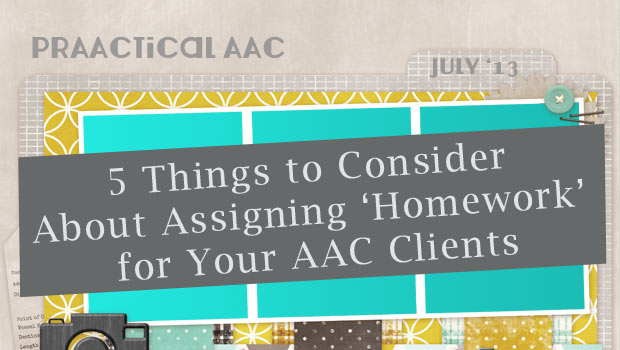5 Things to Consider About Assigning ‘Homework’ for Your AAC Clients

Practicing skills outside of therapy is a good way to extend the learning process and generalize skills to functional environments. It isn’t appropriate for every situation, but when it is, here are some things we try to think about.
1. It should focus on skills they have, not ones they need to learn. Why? Because when we’re learning new things, we get it wrong fairly often. And we don’t want to give them practice getting it wrong. Instead, the home practice should be on things they know and can do, but don’t do consistently. Home practice is a great way to build fluency and automaticity.
2. Tie it into the client’s interests. Use materials or topics that they enjoy.
3. Teach it. Resist the temptation to quickly go over the home practice in the last 60 seconds of therapy or in the waiting room. We’ve all done it, but strive for a different approach. Spending 5-10 minutes of therapy time showing the client what to do, practicing a bit, and perhaps  rehearsing with the caregiver is time well spent. That way, everyone knows what to do and how to do it. That gives time to answer any questions and correct any misinterpretations. We’re more likely to follow through on something when we understand it and feel capable of doing it successfully.
rehearsing with the caregiver is time well spent. That way, everyone knows what to do and how to do it. That gives time to answer any questions and correct any misinterpretations. We’re more likely to follow through on something when we understand it and feel capable of doing it successfully.
4. Use it to prepare for the next lesson. We sometimes have HS students watch a (prescreened) YouTube clip or BrainPop video in order to do things like select vocabulary words they don’t know, but want to learn about or identify key linguistic concepts (e.g., main idea, story starter, transitions, helping verbs, etc). When they come in the next time, we use that as a starting point for the mini-lesson on that word or skill.
5. It’s not appropriate in every situation. If the client needs family support to do the homework, make sure that this works for the family before proceeding. They may not have the time or energy to do these things, or they may not be able to do as much as we originally intended. Better to scale back and send home something small but feasible, then to make the family feel guilty about not being able to tackle the whole thing. That doesn’t do anyone any good.
Do you have thoughts about sending things home for your AAC clients to do between sessions? We’re always looking for fresh perspectives and new ideas!
Filed under: PrAACtical Thinking
Tagged With: 5, family, generalization, home, homework
This post was written by Carole Zangari





2 Comments
Once obtaining permission, I take video of myself working with the AAC user and share with the patents, so they have an example to imitate. If you take video on an iDevice or stand alone digital camera, you can share it using a free cloud, such as Dropbox or Google Drive and the parent’s email address. If you don’t have a one of these (or are crunched for memory) you can use the built-in camera in your laptop and YouTube. Use the upload button on YouTube, select webcam, and after recording, change the settings from public to unlisted so only people you email the link to can view it. Parents have always been very appreciative of my sharing videos. I think it helps build trust too.
Great ideas here, Ann. If you’re interested in fleshing them out into a full guest post, we’d love to have you share more about how you do this. I bet there would be a lot of interest from your fellow SLPs! 🙂